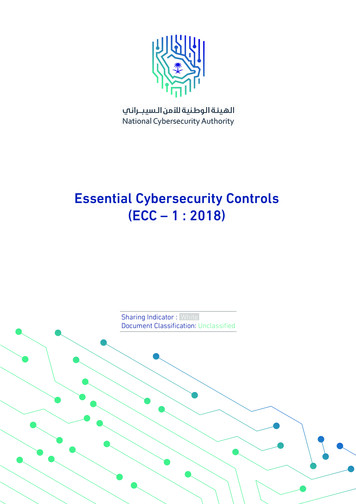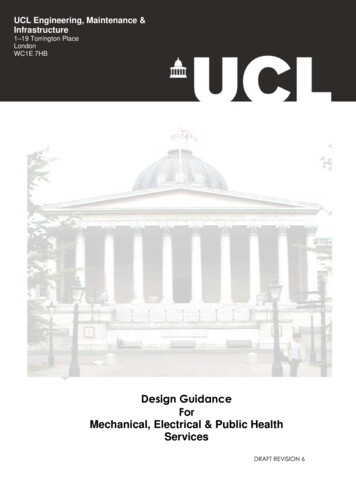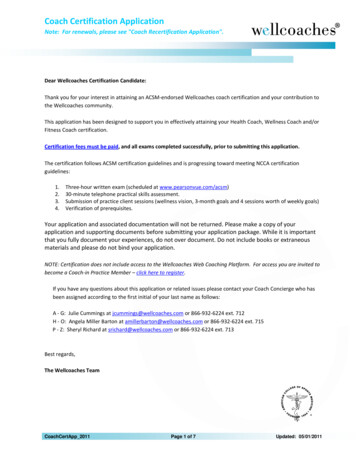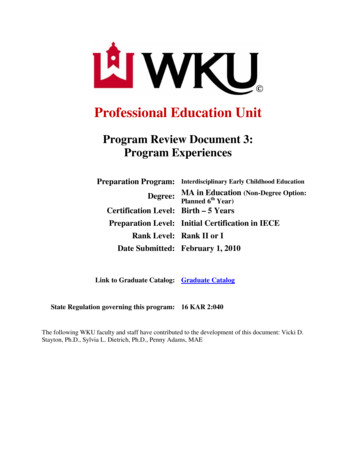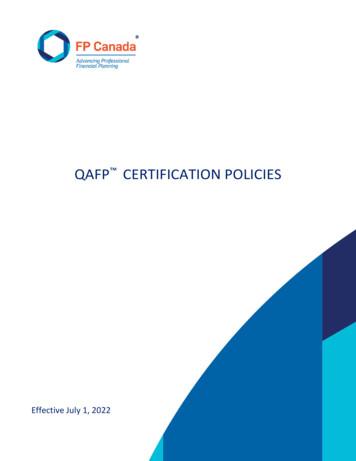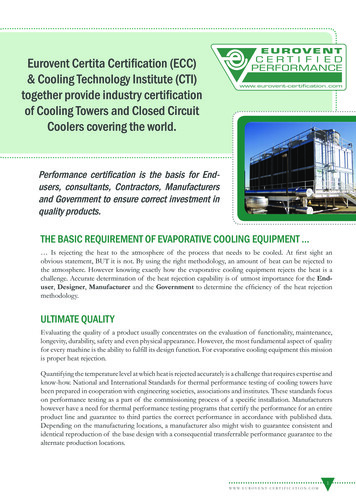
Transcription
Eurovent Certita Certification (ECC)& Cooling Technology Institute (CTI)together provide industry certificationof Cooling Towers and Closed CircuitCoolers covering the world.Performance certification is the basis for Endusers, consultants, Contractors, Manufacturersand Government to ensure correct investment inquality products.THE BASIC REQUIREMENT OF EVAPORATIVE COOLING EQUIPMENT Is rejecting the heat to the atmosphere of the process that needs to be cooled. At first sight anobvious statement, BUT it is not. By using the right methodology, an amount of heat can be rejected tothe atmosphere. However knowing exactly how the evaporative cooling equipment rejects the heat is achallenge. Accurate determination of the heat rejection capability is of utmost importance for the Enduser, Designer, Manufacturer and the Government to determine the efficiency of the heat rejectionmethodology.ULTIMATE QUALITYEvaluating the quality of a product usually concentrates on the evaluation of functionality, maintenance,longevity, durability, safety and even physical appearance. However, the most fundamental aspect of qualityfor every machine is the ability to fulfill its design function. For evaporative cooling equipment this missionis proper heat rejection.Quantifying the temperature level at which heat is rejected accurately is a challenge that requires expertise andknow-how. National and International Standards for thermal performance testing of cooling towers havebeen prepared in cooperation with engineering societies, associations and institutes. These standards focuson performance testing as a part of the commissioning process of a specific installation. Manufacturershowever have a need for thermal performance testing programs that certify the performance for an entireproduct line and guarantee to third parties the correct performance in accordance with published data.Depending on the manufacturing locations, a manufacturer also might wish to guarantee consistent andidentical reproduction of the base design with a consequential transferrable performance guarantee to thealternate production locations.1W W W. E U R O V E N T - C E R T I F I C A T I O N . C O M
For the European HVAC&R industry, Eurovent Certita Certification plays a major role in establishing alevel playing field for manufacturers to certify the performance and guarantee the fundamental integrityof their product lines. The Eurovent Certified Performance logo indicates that this quality requirementhas been fulfilled and should not require the need to be re-proven after the customer’s decision and afterthe manufacturer’s production process. Eurovent certification eliminates the age old practice of including;safety margins, upward rounding of the design loads, wet bulb temperature & flow rate and the budget forcapital investment.ECO-DESIGNThe European Parliament and the council of the European Union have established the climate and energypackage which is a set of binding legislation aiming to ensure the European Union meets its ambitiousclimate and energy targets for 2020. These targets, known as the “20-20-20” targets, set three key objectivesfor 2020 for the EU: A 20% reduction in greenhouse gas emissions from 1990 levelsRaising the share of energy consumption produced from renewable resources to 20%A 20% improvement in energy efficiency.To achieve these targets, the Union has published Directive 2005/32/EC that sets a framework for the ecodesign requirements of energy-using products (EUP). Directive 2009/125/EC is a recast of the 2005/32/EC and extents the scope of application to energy related products (ERP). Finally, the directive 2012/27/EC establishes a common framework of measures for the promotion of energy efficiency within theEuropean Union in order to achieve the Union’s objectives for 2020 and to ensure less dependence onenergy imports from outside the European Union.The above Directives have paved the path for a multitude of specific eco-design directives for machinery.These Directives are applicable for setting energy performance requirements for technical building systems,in particular for testing and calculating energy efficiency of the Energy Using Products as described inthe Directive 2010/31/EU on the energy performance of buildings.According to Mr. Frank Hovorka, Directorof Sustainable Real-Estate at Caisse-de-Depotsin Paris: “Energy efficiency is rapidly gainingimportance to evaluate the value of a building.Real estate managers recognize the importanceof sustainable construction and search for welldefinable parameters to differentiate qualityproducts with proven energy efficiency”.Thermal performance certification is crucialin the process to have an upfront guidance indetermining the current and future value of theinvestment.It is obvious that the ambitious energyefficiency targets set forth by the EU will onlybe met if manufacturers keep the performancepromises they make for their products. Thermal performance certification for cooling towers ensures thatthe promised performance data are actually reached and therefore certification helps to meet the EUenergy targets.2W W W. E U R O V E N T - C E R T I F I C A T I O N . C O M
THERMAL PERFORMANCE CERTIFICATION FOR EUROPEThermal performance certification has remained a recurring item on the agenda of the Eurovent association’sProject Group “Evaporative Cooling Equipment”. The rapidly changing European legislation, the drive forsustainable Eco-design buildings and the awareness that certified cooling tower will improve the credibilityof a naturally top-energy efficient evaporative cooling circuit, convinced the cooling tower manufacturersto re-start a certification programme.Crucial for a successful new certification programme were Use of generally accepted certification standards for full product line certificationEqual accessibility to the programme for European as well as International manufacturersGlobal acceptance to support the export oriented European marketCertification through laboratory as well as field-testing to increase the programme participationflexibility by all manufacturersTo facilitate the establishment of this programme a Memorandum of Understanding (MoU) was signedbetween Eurovent Certita Certification (ECC) and the Cooling Technology Institute (CTI). This MoUdescribes the cooperation between both organisations in which CTI provides the structure and knowhow for thermal performance certification and ECC provides the administration to ensure consistencyof the certified products and promote the certification programme in Europe. CTI’s strong internationalreputation and recognition supported by ECC’s solid administration guarantees a top quality effectivecertification programme.CERTIFICATION PROCESSThe procedures as described in the documents“Operational Manual OM-4-2014 for the Certificationof Cooling Towers” and the “Rating Standard forCooling Towers RS 9C/001-2014” are applicable.In accordance with OM-4-2014, the certificationprocess starts with the application for certification.The manufacturer submits to ECC all relevantdocumentation for each applied product range andalso declares to accept the general rules as writtenin the General Eurovent Certification Manual.The most important document to provide is theData of Record (DOR) that defines technicallythe exact construction of the cooling equipmentmodels to be thermally certified.NOCTIcertifiedYESData analysisTechnicalcommitteeApply ECCApprovedData analysis& ThermalperformancetestingPassedManufacturerplant auditManufacturerplant auditPassedECC certificatedeliveredPassedECC certificateThe qualification procedure follows a successfuldeliveredapplication. The manufacturer qualifies a productline by executing an initial thermal performancetest in accordance with Eurovent RS 9C-2014 andexecuted by the CTI licensed thermal certificationperformance test agency. This rating standard RS 9C-2014 refers directly to the CTI STD201 (OM/RS)– Thermal Performance Certification of Evaporative Heat Rejection Equipment & Performance Ratingof Evaporative Heat Rejection Equipment. Cooling tower lines that already are CTI-certified transposethis CTI certification into the Eurovent certifying framework. In order to guarantee exact duplicationof construction of the transposed equipment, Eurovent OM-4-2014 defines a factory audit procedure:basically all DOR entries of a randomly selected cooling tower manufactured in the European facility are3W W W. E U R O V E N T - C E R T I F I C A T I O N . C O M
audited and confirmed identically compared to the product that has been CTI-certified outside of Europe.A successful thermal performance test in accordance with CTI STD 201(RS/OM) and a successful factoryaudit result in a Eurovent certification.Repetition is crucial to guarantee consistence of performance and construction. CTI STD201, and as perconsequence also OM-4-2014, define an annually recurring reverification test executed by the CTI licensedthermal certification performance test agency. Positive performance test and factory audit reports resultin a renewal of the Eurovent certification. However performance tests and factory audits might concludewith a less than satisfactory result. Failure treatment is therefore an integral part of OM-4-2014 and clearprocedures are described on how to implement corrective measures and consequences. Failure treatment canbe activated during the qualification and re-verification procedure and as a result of a customer complaint.Failure treatment cannot be taken lightly by the manufacturer. Unsatisfactory results can bring thecertification of the entire product line into question and can lead to revocation of this product line fromthe Eurovent Certita and CTI website and notification of the failure to the entire CTI membership and tothe industry.CERTIFICATION VERSUS INDEPENDENT FIELD TESTINGThe purpose of certification is to set forth a programme to assure users of evaporative cooling equipmentthat all models from a product line of a specific manufacturer are thermally performing in accordance withthe published ratings. The manufacturer is assured that the thermal performance testing as the basis forthe certification of the product line responds to the rules of honest competition on a level playing ground.Certification does stand for voluntary participation to thermal performance testing and factory auditsapplying identical rules for all participating manufacturers. In order to guarantee accurate undisputabletest results, all equipment utilised for an initial qualification or re-verification test shall be owned by CTIor the CTI licensed thermal certification test agency and be approved by the CTI Thermal CertificationAdministrator. Calibration schedules and instrument accuracies are also stipulated.Only a limited number of CTI licensed certification test agencies have the authority to execute thermalcertification qualification and verification tests. All licensed certification test agencies are carefully selectedand often can count on decades of experience. They use identical procedures for thermal certificationtesting and all forward the thermal test results to the CTI Certification Administrator for consistentevaluation of the results.In Europe, due to the absence of an industrywide participation to a certification programme for many years,owners and consultant used to accept manufacturer’s performance declarations. In some cases testing inaccordance with standards like “EN13741 Thermal performance acceptance testing of mechanical draughtseries wet cooling towers” is required. The use of inexperienced, non-licensed test agencies could howeverresult in questionable results, and with undesirable statistical addition of tolerances coming from inaccuratereadings taken with contestable equipment to adjust the result.The independent thermal performance field test is mostly part of the commissioning process and thereforeexecuted immediately after completion of the technical installation. Nevertheless, due to the nature of abuilding project, the cooling requirements at that stage seldom reaches design conditions. In most cases,achieving a stable operating condition is already a challenge on its own. A valid thermal performancefield test, requiring stable fluid flow and process temperatures and a stable wet bulb temperature, is oftenchallenging in the majority of situations. Tests and re-tests can be required, sometimes by an alternativetest agent with different measuring equipment, techniques and know-how. On top of these challenges, alimited time slot for a good thermal performance test (typically during mid-summer) complicates it further.4W W W. E U R O V E N T - C E R T I F I C A T I O N . C O M
On top of all of that there is the extracost to the owner of the acceptancetest for commissioning. All thisdemonstrates clearly the benefit ofa thermal performance certificationprogramme.Certification of evaporative coolingequipmentguaranteesthermalperformance prior to shipment of theequipment and at no cost for the owner!The installation of l costs for correctivemeasures or continuous payment ofenergy consumption penalties overthe life of the equipment are avoided.According to Mr. Roi Wanders,Mechanical Engineer at JacobsEngineering in Belgium: “Theimportance of thermal performance certification lies in the fact that it establishes great confidence in theproduct and prevents distress and unexpected design flaws once the installation is being commissioned oroperated by the end-user”.CONSEQUENCES OF UNDERPERFORMANCEA deficiency in cooling tower performance often goes unnoticed in many installations. The evaporativecooling equipment is a part of a cooling circuit, often combining multiple components. Each of thecomponents of this cooling circuit influences the other linked components and the efficiency of the systemis dependent on the strength of the weakest link.Lack of thermal performance of the evaporative cooling equipment has a limited effect on the energyconsumption of the evaporative cooling equipment itself. What is often more important is the energyconsumption of the overall system which the evaporative cooling equipment serves. In a conventionalHVAC cooling system for example the fan (and pump) power of the evaporative cooling equipment issmall compared to the electrical power of the chiller (often by a factor of 10). Yet, the compressor poweris directly related to the condensing temperature of the chiller and this condensing temperature is directlydefined by the performance of the evaporative cooling equipment. The ambient temperature at whichan HVAC-system can switch to free cooling also decreases. This dramatic effect of underperformingevaporative cooling equipment on the electrical power of the chiller goes far beyond the few percentagepoints of gain that a chiller manufacturer can offer by installing highly efficient electrical motors (as requiredby the EU directive 640/2009/EC). The operating cost impact is equally dramatic and results in a yearlyrecurring increased electricity invoice. Additionally, the tower must work harder to satisfy the expectedthermal performance, resulting in the use of even more electrical power.Depending on the application, underperformance of evaporative equipment can also lead to an increasedtemperature in a building. Depending on the building purpose, the consequence can be acceptable for ashort period only or simply be unacceptable. Underperformance of evaporative cooling equipment forindustrial application (whether or not with a chiller in the cooling circuit) can lead to significant productionloss and operational danger and is usually unacceptable.5W W W. E U R O V E N T - C E R T I F I C A T I O N . C O M
Capacity deficiencies can lead to risk for a continuous operation and are most of the time difficult to detectprior to commissioning. Most of the time, these deficiencies go undetected and are a continuous energypenalty that must be paid by the owner. Conservative assumptions in building load calculations, reducedbuilding occupancy, off peak ambient conditions and the use of higher than design wet bulb temperatures willoften cover effects of undersized evaporative cooling equipment. Yet the negative effects to the owner/endusers will remain. Oversized systems often perform poorly as compared to properly sized cooling systems.HOW TO SPECIFY THERMAL PERFORMANCE CERTIFICATIONThermal Performance and Efficiency:The cooling tower shall be capable of cooling l/s of water from C to C at a designentering air wet-bulb temperature of C.The thermal performance shall be ECC certified in accordance with ECC and CTI certification standards.Equipment without ECC certification will be subject to a field or factory acceptance thermal performancetest executed by a qualified independent third party testing agency in accordance with a recognized standard.Specification ValueCertification assures the buyer that the tower is not intentionally or inadvertently undersized by themanufacturer. Certification alone is not sufficient to assure you that the tower will perform satisfactorily ina particular situation. Certification is established under relatively controlled siting conditions, as defined inmanufacturer’s literature, but towers are not always installed under such circumstances. They can be affectedby nearby structures, machinery, enclosures, effluent from other cooling towers, etc. Designers and ownersmust therefore take such site-specific effects into consideration when selecting the tower in order to assurefull thermal performance. The buyer must insist, on the written specification (including description of thosesiting conditions) that the designer/manufacturer is responsible to guarantee this “real world” performance.Nevertheless the installation of a certified product gives the owner assurance that the product itself providesthe performance he has paid for. Manufacturers publish layout guidelines, installation manuals, and operatingand maintenance manuals, all of which should be followed for a successful installation.CONCLUSION AND BENEFITS OF THERMAL PERFORMANCE CERTIFICATIONOwner/End-Users are the most important partners of thermal performance certification. They decide thekey-requirements of the equipment for the consultant to specify. The end-user is the provider of the capitalbudget and pays the monthly energy bill of the cooling system. As stipulated in the previous paragraph,the performance of the cooling tower is essential for the performance of the entire cooling system. This isa crucial factor in the evaluation of the sustainability and long term value of the real estate and industrialfacilities.Below you can find a summary that lists the specific benefits of Eurovent-CTI thermal performancecertification for cooling towers and closed circuit coolers. Owners and end-users: Thermal performance guarantee of the equipment at no additional cost.Installation of equipment that is rated and evaluated on equal terms enabling honest evaluation ofcompeting offers on a level playing ground with a 100% thermal capacity return for the investment.Government, EU regulators: Reliable independent basis for the efficiency evaluation of the energyusing product. Full scale programme accessible for all manufacturers in a global market.Design engineers: Reliable standards to specify and avoid deficiencies attributed to the design of thecooling system. Similar as for the owner/end-user, thermal performance certification is a key decisionmaking factor that guarantees honest comparison of suppliers at no additional cost for the owner/enduser.6W W W. E U R O V E N T - C E R T I F I C A T I O N . C O M
Contractors: No costly call back due to capacity deficiencies. Exclusion of capacity doubts for thecertified components in case of cooling system under performance due to third party issues. Basicrequirement to build relationships with trustworthy suppliers.Cooling tower manufacturers: Honest competition based upon standards established by evaporativecooling experts resulting in faster product development and sustainable innovation.Thermal performance certification is a basic element of a successful, sustainable design and offers significantbenefits to all segments of the industry.EUROVENTEurovent is Europe’s Industry Association for Indoor Climate, Process Cooling, and Food Cold Chain Technologies. Itsmembers from throughout Europe, the Middle East and Africa represent more than 1.000 companies, the majority small andmedium-sized manufacturers. Based on objective and verifiable data, these account for a combined annual turnover of more than30bn Euros, employing around 150.000 people within the association’s geographic area. This makes Eurovent one of the largestcross-regional industry committees of its kind. The organisation’s activities are based on highly valued democratic decisionmaking principles, ensuring a level-playing field for the entire industry independent from organisation sizes or membership fees.Eurovent’s roots date back to 1958. Over the years, the Brussels-based organisation has become a well-respected and knownstakeholder that builds bridges between manufacturers it represents, associations, legislators and standardisation bodies on anational, regional and international level. While Eurovent strongly supports energy-efficient and sustainable technologies, itadvocates a holistic approach that also integrates health, life and work quality as well as safety aspects. Eurovent holds in-depthrelations with partner associations around the globe. It is a founding member of the ICARHMA network, supporter of REHVA,and contributor to various EU and UN initiatives.The main objective of the Eurovent Certita Certification (ECC) programme isto certify cooling equipment (and/or components) independently from EuroventAssociation. ECC has its own dedicated Technical, Marketing, Sales and Legaldepartment and is structurally independent from Eurovent Association. EuroventCertita Certification is widely established and well known in the European Cooling industryand defends a strong position of being a credible well organized and trustworthy partnerfocusing on a mutual European approach establishing a level playground amongst all players on the European market. Currently,17 performance certification programs are active and monitored bydedicated auditors and program managers.Eurovent Certita Certification established the first cooling towercertification programme during the early 90’s. The Eurovent 9.2manual “Thermal Performance Acceptance Testing of MechanicalDraught Standardized Water Cooling Towers” was created by allmain cooling tower manufacturers in Europe at that time. However,the program suffered from lack of participation and did not succeedto gain leverage in the market. At the beginning of 2012, ECC hasestablished its new certification programme for Evaporative HeatRejection Equipment in collaboration with CTI. The programme isin its 3rd year with manufacturer participation covering a substantialpercentage of the European market.For additional information of the Eurovent Certita Certification programme for Cooling Towers, visitwww.eurovent-certification.com website or contact Mr. Ian Butler MSc. (ECC Programme Manager forCooling Towers).7W W W. E U R O V E N T - C E R T I F I C A T I O N . C O M
COOLING TECHNOLOGY INSTITUTE (CTI)The Cooling Technology Institute (CTI) is a nonprofit, self-governing technical association ofmanufacturers, suppliers, owners, operators and designers. Membership is open to all partieswith an interest in heat rejection technology. Among CTI’s stated objectives are a dedicationto the advancement of technology, design and performance of heat rejection equipment, theprevention of water and air pollution, and the conservation of water as a natural resource.CTI was founded in 1950 and has provided a medium of information and data exchange among manufacturers and users ofEvaporative cooling equipment and associated products for over sixty years. CTI meets semi-annually to conduct business,technical paper presentations and advance committee work on CTI guidelines, standards, codes, and white papers. It alsodevelops standardized testing codes and standards and engages in and supports research. A key objective of CTI has beento establish and promulgate the use of codes, standards, and specifications aimed at obtaining uniformly good quality in heatrejection technology.For over sixty years, the CTI also provided cooling tower performance testing services to members and non-members. Startingin January 1993, the CTI has provided these testing services through multiple testing agencies, each examined, qualified, andlicensed by the CTI to conduct such tests. The documents establishing the program, and under which it currently operates, aredeveloped by a task force under the auspices of the CTI Board of Directors.The mission of CTI is to advocate and promote the use of environmentally responsible Evaporative Heat Transfer Systems(EHTS), cooling towers and cooling technology for the benefit of the industry by encouraging education, research, standardsdevelopment and verification, government relations, and technical information exchangeCTI Objectives: Maintain and expand a broad-base membership Identify and address emerging and evolving issues Encourage and support cooperative research Assure acceptable minimum quality levels and performance Establish standard testing and performance analysis systems and procedures Communicate with and influence governmental entities Encourage and support forums and methods for exchanging technical informationCTI published their first STD-201, the“Certification Standard for CommercialWater Cooling Towers” in 1962. Later thisstandard became the “Standard for ThermalPerformance Certification of EvaporativeHeat Transfer Equipment”. The latest revisioncreated an OM & RS as mentioned previously.Initially, this standard described an extensivematrix of tests to qualify. Similar to thefirst Eurovent Cooling Tower Certificationprogram, the initial CTI program also requiredsubstantial resources that many manufacturerscould not justify. After a period of evaluationand revisions of STD-201, the participationto the program started in 1981. The programstarted to grow significantly from 1992onward as seen in the graphs. Currently, 34manufacturers and 8 private brands are listedwith one or more CTI certified product lines.For additional information on the CTI, visit www.cti.org or contact Mrs. Virginia A. Manser, CTIAdministrator at vmanser@cti.orgW W W. E U R O V E N T- C E R T I F I C A T I O N . C O MAUTHORSRob Vandenboer, Subgroup Marketing StrategyChairman, Cooling Tower Compliance CommitteeIan Butler, MSc – Project Manager, EuroventCertita CertificationCT/ECC/2015/v01
Project Group "Evaporative Cooling Equipment". The rapidly changing European legislation, the drive for sustainable Eco-design buildings and the awareness that certified cooling tower will improve the credibility of a naturally top-energy efficient evaporative cooling circuit, convinced the cooling tower manufacturers

